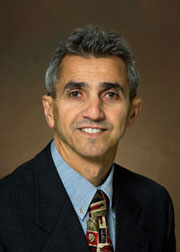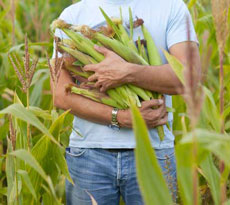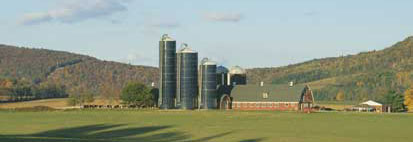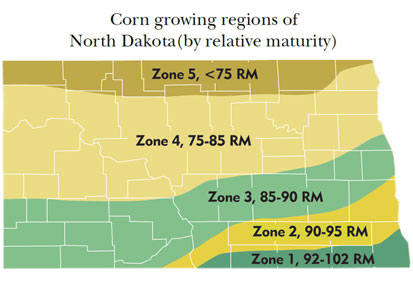
Adnan Akyuz, North Dakota’s
state climatologist
From flooding in Bangladesh to desertification in Africa, climate change is altering landscapes around the world, but the impact varies widely. Here in America’s breadbasket, there is a lot of concern about how changes in temperature and rainfall will affect agriculture.
One person watching these changes closely is Adnan Akyuz, North Dakota’s state climatologist. Prior to his current role, Akyuz worked for the National Weather Service and served as the state climatologist for Missouri. He earned his doctorate in atmospheric science at the University of Missouri-Columbia.
In talks to a variety of audiences, from farmers to insurance companies, Akyuz highlights the effects of climate change on agriculture. Surprisingly, they’re not all bad.
fedgazette: Tell us about your research and how you got into the topic of climate change and agriculture.
Adnan Akyuz: My latest research was to look at the growing-degree days for corn. It started out to be just North Dakota and the Northern Plains, but it got really broad-ranging interest, and so we extended the research to the entire United States. Now we are able to compile the data for the entire United States and see how the growing-degree units for corn have changed. All of the data we have go back to 1890, including for several locations in North Dakota.
fedgazette: In a talk at the recent annual meeting of the North Dakota Association of Soil Conservation Districts, you suggested that “climate change is not really all bad” for North Dakota agriculture. Can you explain what you meant by that?
Akyuz: I was talking about the research, and I was taking a positive angle and letting the audience know something that they haven’t heard before. North Dakota has the greatest warming trend in the lower 48 states, with a 0.26 degree Fahrenheit per decade increase since 1890. When you compare this result to the other states with a similar approach, you will find this trend to be the highest in the United States. In North Dakota, in general, we are 2.6 degrees warmer today than we were 100 years ago. But I have to mention that’s only the average; if you look at these annual fluctuations, you will find much variability from one year to the next. At the meeting, I also added that the warming in North Dakota has some positive implications in agriculture and talked about those.
fedgazette: Do you have any sense for why North Dakota has the most dramatic temperature increase? Is it because of location?
Akyuz: We are right in the middle of the continent and, in fact, the city that is right at the center of the continent is Rugby, North Dakota. That makes our climate very tough in the summertime, since we are far away from the protective nature of the oceans. It takes nearly five times as much energy to warm a gram of water compared to a gram of land, so in the summertime, we get warm very fast. In the wintertime, we get cold very fast. Because of the region’s geographical position with respect to the oceans, the warming trend is accelerated here.
fedgazette: What does this warming trend hold for North Dakota agriculture?
Akyuz: In the latest research that we did on growing-season length in North Dakota, we found that the state has gained, on average, 1.2 additional days per decade in which the crops can grow. So we can say that we have 12 additional days today compared to 100 years ago that were suitable for crop growth. I can do this with each city; in Fargo, averaged over time, we have 17.5 additional days in which our crops can grow today compared with 100 years ago.
Moving one step further, in North Dakota, if you look at the map, you will see about five zones, starting from the south and going to the north. The farmers in the southernmost zone normally plant [corn with] 92 to 102 days relative maturity, and that type of corn matures when growing-degree days—the necessary heat units for the corn to reach maturity—reach 2,250 to 2,500. And in the north of the state, relative maturities are less than 75 days, and these types of corn require only 1,850 to 1,950 growing-degree days. So, yes, corn is possible, even in North Dakota, as long as you can plant the type of corn that grows in that region. But the problem is that when you select the variety that matures in less than 75 days, your yield is going to be very little compared to the varieties that mature in 90 to 102 days.
As for Fargo, we notice that 335 additional heat units are available today for corn development compared with 100 years ago. That 335 [units] happen to be 16 percent of the total heat units that are necessary to mature corn in Fargo. That is more than a three-category jump in relative maturity class from 70-day corn to 85-day corn, and 85-day corn has a greater yield capability than 75-days. So maybe 100 years ago, planting 85-day corn in Fargo was almost a dream. But because of our changing climate, this all of a sudden becomes possible. Even though the 335 additional heat units seem to be a meager 16 percent of total, it could be the decision factor a farmer will need to plant or not to plant corn in a given season.
fedgazette: That’s certainly consistent with the increase in corn production we’ve seen in the Dakotas.
Akyuz: There is a significant trend toward corn production in our area. A big shift from small grains or other traditional crops to corn is observed more and more lately.
fedgazette: So, can you generalize that trend to the broader region? Is that true, for example, of Minnesota and South Dakota as well?
Akyuz: I wouldn’t go too far from the Dakota area. I may be able to generalize to the Northern Plains, North Dakota, northern Minnesota and South Dakota. Farmers, at the beginning of the season, are trying to make a decision—what if I plant corn this year, would I make it by the end of the season? If I planted a higher relative maturity type of corn to improve my yield and profitability, would I put myself at risk of not reaching maturity by the end of the season? It gets to be an easy decision if you live in a state that has the highest warming trend.
fedgazette: So what about variability? You said that there’s a clear warming trend year over year, but has the variation from year to year changed as well? Are there more extremes between warm and cold years now, say, than there were 100 years ago?
Akyuz: Yes, absolutely. North Dakota is also the state that has the highest annual temperature range swing. In 1936, for example, the state’s highest temperature and the lowest temperature ever recorded happened in the same year. On July 6, we had 121 degrees in Steele, and in the very same year on February 15, in Parshall, which is less than 100 miles away, a low of -60 degrees. That is actually the highest annual temperature range in the world: 181 degrees Fahrenheit. Some of the other locations that might challenge this are in Siberia, and they have similar records, but those ranges are within 100 years; North Dakota broke this record in the same year.
North Dakota farmers are already familiar with this variability and, yes, you’re right. One year it might be very warm, warmer than normal; the other year is much cooler than normal. But if you look at it in general, there’s a warming trend, especially starting in 1970.
fedgazette: Does that introduce a new element of risk to farmers who are experimenting with warmer weather varieties of corn?

Akyuz: Yes, absolutely. At the same time, I don’t see any farmers going too crazy about selecting, for example, in the Fargo area, 95- to 100-day relative maturity of corn. They are still cautious. They are still sticking with the climatological normal, say, 85-day corn. You might find some farmers taking risks by putting in even warmer varieties, and those are the types, for example, that last year did not make it. Most corn in North Dakota did reach maturity, but it was so late in the season, and some of this corn did not get a chance to dry in the field. Then we ran into propane [availability] problems. Some farmers decided to leave their corn in the field; they just couldn’t get the chance to harvest before the snow came.
There is also an upper threshold for corn, which is 89 degrees, and then the accumulated growing degrees for corn just stop. At other locations, the temperatures are so high, it impacts your crop negatively. So, if you have a field in Missouri, Iowa, Indiana, Kentucky—those regions are having no problem reaching that threshold and might be impacted negatively. North Dakota is not going to have that kind of problem with the upper threshold. So, it is possible that the warming trend might be bad news in the other states that already reached that threshold. But for locations such as North Dakota, the shift from small grains to corn will continue.
The portion of the variation that scares me the most is the last day of the spring frost, which is occurring earlier and earlier. Some years, you’ll have a very early spring and the warming trend will start from that point on. A very late frost in the Midwest in 2007 caught most flowering plants and trees much later in their developmental stage, causing extensive total losses in Missouri and neighboring states. The temperatures dipped down to killing-frost points and killed very much of everything that was flowering. This risk is always there. Even though the last day of the spring frost is occurring earlier in general, that doesn’t guarantee a later frost the next year. Year-to-year variability will always be a risk.
In North Dakota, however, we have mostly row crops and not many trees. We have climate variability like no other state because of our continental properties. 2012, for example, was the second-warmest year since 1890, but following that was the 33rd-coldest year of the same period. So I think by nature North Dakota citizens and farmers are more resilient to changes because season-to-season fluctuation is a part of our climate and we expect it. When somebody says “normal,” it has a different meaning elsewhere than it does in North Dakota because “variable” is what’s normal in North Dakota.
fedgazette: What does the change that you’ve observed in temperatures imply for some of North Dakota’s traditional crops, like wheat and canola? Are those crops in any way threatened by this, or do you see this transition as just more profitable to corn?
Akyuz: Some of the other small grains—wheat for example—do not require as many heat units as corn does. However, corn has become very popular and profitable and marketable. Farmers can market their corn for food, fuel and feed. I don’t think any farmers will have any problem marketing their corn. You have a set amount of acreage in your field, and you know corn is going to grow and it is more profitable. As long as the demand for corn exists, the market proves to be more profitable and the climate continues to be favorable for corn production, the trend to move away from other traditional crops to corn will continue. Therefore, it is not only the climate that is threatening traditional crops, it is the market.

fedgazette: So far, we’ve talked about temperatures and the length of the growing season. Have you looked at all into precipitation? Don’t some forecasts suggest that the Great Plains could become drier?
Akyuz: We are continental. That means we are very vulnerable to water sources, and the biggest water source is precipitation. Our precipitation amounts are very meager. Our [average] precipitation total in southeast North Dakota is 21 inches, northwest is 15 inches, and most of our precipitation falls in the summertime. That 21 inches in the southeast is almost just enough to have any crops grow. If I look at the precipitation records in the past, just like I did the temperature, I would notice a 1.12-inch-per-century increase since 1890. In North Dakota, precipitation has actually increased in time. In 2013, North Dakota had the wettest year in its history with 24.64 inches. Our driest year was 1936 with 8.67 inches of rain. These are very small numbers compared to some of the other corn-producing states.
Any time you increase the temperature, you can hold more water vapor in the atmosphere. Not only this, but corn has deep roots and is able to tap into the lower parts of the soil and draw that moisture back through the stem and into the atmosphere through a process called transpiration. We started seeing high dew point temperatures lately in this area, and I believe the main reason is the trend of corn production in this area is putting a lot of moisture that would otherwise remain in the soil back into the atmosphere. The greater amount of water vapor in the air translates into greater amounts of available water for rainfall. So you have warmer temperatures, which allow corn to grow, and at the same time, corn taps into deeper portions of the soil to bring more moisture back into the atmosphere, which also can increase precipitation because air can hold more water vapor in it as the temperatures are higher.
fedgazette: Finally, what’s the long-term outlook between climate and agriculture in North Dakota and the broader region?
Akyuz: I think farmers are going to respond to what the climate allows them to plant. We will see the migration of popular plants from southern locations to northern locations. In our latitudes, more and more farmers are going to keep planting profitable plants, such as corn, and small grains, such as wheat and barley, will continue to move northward into Canada, for example. If the warming continues, we might see some Canadian neighbors start planting what grows in Fargo.
As far as climate prediction is concerned, farmers are not generally interested in knowing the 100-year outlook; they are mostly interested in the next growing season. I need to make a decision, and I want my decision to be science-based. When am I going to be able to get into the field, and how long do you think the growing season is going to last? Are the fall temperatures going to be warm enough so I don’t have to use mechanical drying? These are the decisions that farmers are up against. Climate change itself makes it very difficult to make a forecast that farmers can rely on. So I think that as meteorologists and climatologists, our challenge is to improve our forecasting skills for the next growing season so that farmers can be ready.
fedgazette: Thank you, Dr. Akyuz.
Joe Mahon is a Minneapolis Fed regional outreach director. Joe’s primary responsibilities involve tracking several sectors of the Ninth District economy, including agriculture, manufacturing, energy, and mining.






